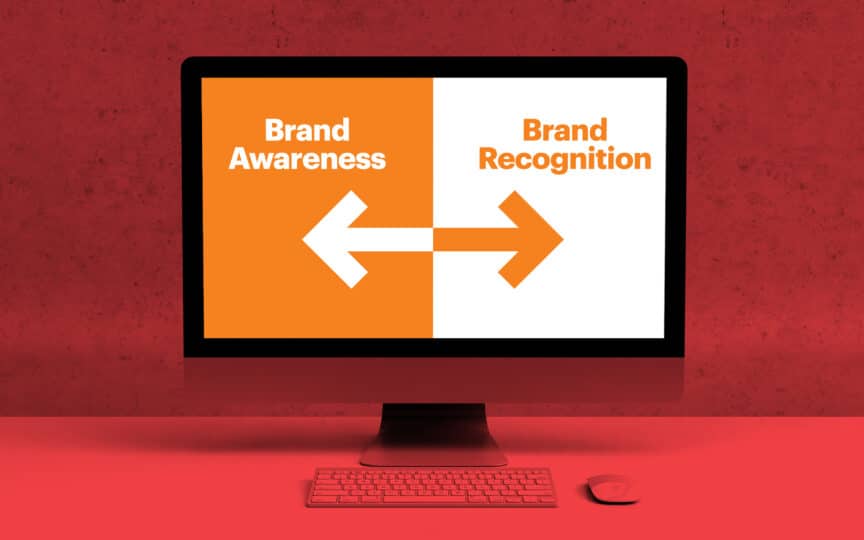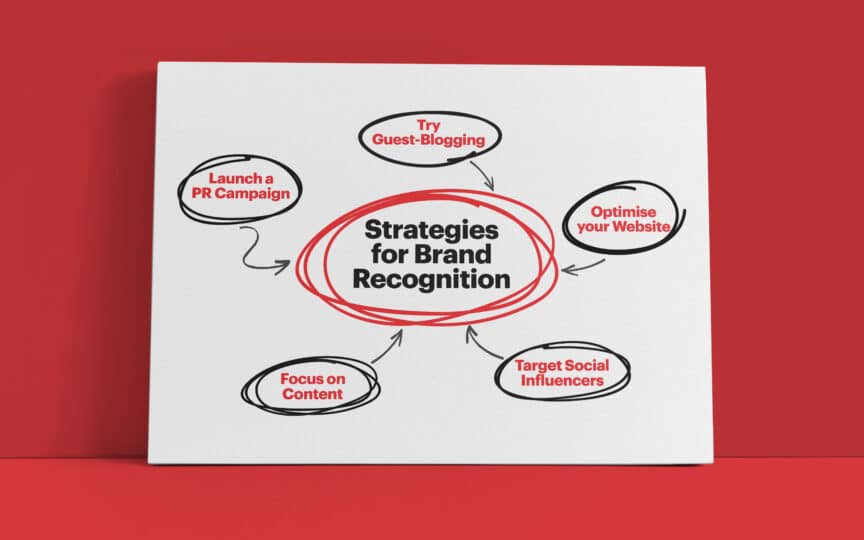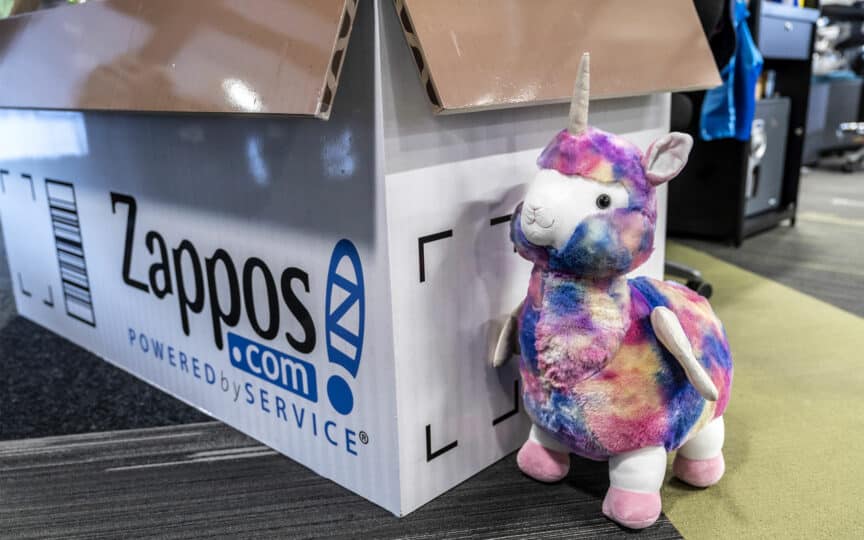Brand recognition or brand awareness: What’s the difference?

What’s the biggest issue your brand is facing right now? Think it’s money? Pricing? Investment? Nope, think again.
Ultimately, “obscurity” is the biggest concern facing any business. If your customers don’t know who you are, then they’re not going to give you their trust, their attention, or their cash. It’s the threat of “obscurity” that makes marketing agencies in London so popular, and leaves modern businesses constantly scrambling to stay ahead of the competition.
If you want to not only achieve success for your business, but make sure that you can maintain that success over time, you need a little something called “brand awareness“. Brand awareness is the result of brand recognition, and brand recall. It’s the secret sauce that transforms your company from “just another business” into a household or industry name.
Though brand awareness might inspire more loyalty and brand affinity than “recognition”, you need both elements if you’re going to create a powerful future for your company.
Today’s brands are notoriously bad at getting attention. Don’t worry – it’s not all your fault. The modern generation of consumers are practically ninja-efficient at swatting away advertisements, ignoring popups, and overlooking new companies.
The good news is that satisfying your all-important thirst for attention doesn’t have to mean investing millions into your marketing agency, or testing a hundred different strategies. Here, we’re going to tell you everything you need to know about brand awareness, and brand recognition – and how you can get the best out of both.

Separating brand awareness from brand recognition
First things first, if you want to make the most of your brand recognition and brand awareness strategies, then you need to understand that they aren’t the same thing. “Brand awareness” and “brand recognition” are terms that are often used interchangeably, but there are key differences between the two and you need to know those differences before you begin building offline, and online presence.
Brand recognition is exactly what you might expect. It’s how the members of the public, or your target audience, can “recognise” your brand. Beyond a memorable business name, a good brand recognition strategy involves developing colour schemes, logos, visual elements, and even a tone of voice that your customers can attribute to your brand.
When used with care, brand recognition strategies can make your company name synonymous with whatever service or product you might provide. In fact, the connection can be so deep, that some brand names have become a part of our natural language. For instance, you don’t search for a product, you “Google it”. When you want to write a memo, you don’t use a sticky note, you use a “Post-It”.
Most of the time, brand recognition strategies are focused on keeping your company in the eyes and minds of your customers at all times. That means creating a consistent visual and verbal strategy, ensuring that you’re on the right social media platforms, and making efforts to improve your marketing reach.
Though brand recognition is an obvious element of brand awareness, the definition of brand awareness is much more refined. Brand awareness is about building a connection between your company, and your customer. Rather than just knowing what your brand does, or being able to identify you from your logo, your “brand aware” customers will instantly know that your product is the best solution to their problem.
Brand awareness is about pinpointing what makes your company different, and using those differences to show the inherent value of your company. Though “recognition” highlights your unique aspects in terms of voice, strategy, and image, “awareness” focuses on the heart and soul of your company, everything that comes together to convince your customers to choose you over anyone else.
It’s clear to see that brand recognition and brand awareness go hand-in-hand, so let’s talk about how you can achieve them both.
Promotional strategies for brand recognition
Brand recognition generally focuses on making your company more “visible” to the public. Though you’ll need to think carefully about your voice, your image, your personality, and your values to deliver a consistent brand experience, you’ll need to implement your ideas for brand recognition into an integrated communication strategy that promotes your company.
To start your journey into brand recognition, make sure that you have everything you need to make your brand easily recognisable. This means considering the unique elements of your brand identity. Design a professional logo that’s consistent with your other branding elements. Choose the colours and shapes you want people to associate with your brand. Think about how your backstory can link in with the things you do today. Your marketing agency should be able to help with all of this.
Once you have your identity in place, you can begin to promote it with a range of techniques, including:

1. Launch a PR campaign
PR campaigns are a common solution for brand recognition. They help to introduce people to your company with simple, affordable press coverage. Because editorial publications usually have more credibility than start-up brands, a PR post could convince new customers to check you out when you’re just bringing your brand to life.
To help make your PR campaign more appealing from the perspective of brand recognition and brand awareness, you should think about unique ways to draw attention to what makes your company different. For instance, can you share a story about why you started your company? Have you launched a unique new product to solve a problem you know your customers have?
2. Try guest-blogging
Another way to spread the reach of your brand to new audiences, is to get involved with guest posts, or “guest blogging”. If you know something about your industry that your customers might want to learn, or you have valuable information to share, then there are plenty of blogs out there that will be willing to give you a platform.
With a guest blog, you can start to build the authority of your brand, and help customers to recognise you, even before you start to invest in complicated marketing techniques and offline events.
3. Optimise your website
Sometimes, companies are so focused on developing a best of sector website design, that they forget to think about optimising their online presence first. Having a professional and attractive website is important, but optimising that website for performance and SEO rank is crucial too.
Think about what you would like your customers to recognise about your brand. For instance, if you’re a fashion retailer, then you might want your suppliers and customers to think about you whenever they think of “men’s fashion”. Implementing those keywords into your website will also help you to rank better on Google, and ensure that you show up for the phrases new customers are searching for.
Of course, there’s more to optimising your website for brand recognition than using keywords. You’ll also need to make sure that your landing pages, product pages, and blogs all use shapes, colours, fonts, and images that are consistent with your brand identity.
4. Target social influencers
When you’re just starting to spread brand recognition for your company, it can help to access the authority of other professionals in your niche. Influencer marketing is just one of the many ways that you can borrow the impact of big-name brands and companies in your sector, to give value and leadership-status to your own company.
The key to influencer marketing is making sure that you not only target the right influencers, but also ensure that you issue your “shout-out” efforts over the right platforms. Think about where your ideal customers spend their time, and then reach out to a collection of influencers to make your brand more recognisable to a particular niche.
5. Focus on content
Content is crucial to both marketing and branding alike. With the right content marketing strategy, you can not only build recognition for your company, but also earn the trust and loyalty of your customers too.
When it comes to building brand recognition, focusing on content means that you have more value to share across different platforms. That means that you’re creating numerous points of contact with your audience online, which instantly makes your company more familiar. The more your audience sees your blog posts shared on social media, or your videos referenced in other articles, the more recognisable your brand becomes.
Just remember, if you want to leverage the full value of content, everything you post should be valuable. Don’t publish for the sake of generating online volume, publish to give something back to your customers.
Brand awareness strategies that improve customer retention
Once you’ve begun to earn the attention of your target customers with brand recognition strategies, you’ll need to earn their loyalty and respect with brand awareness campaigns. There are countless ways that you can show off the value of your brand to your audience, but here are the three most efficient (and effective) methods, recommended by marketing agencies.
1. Provide an education
Brand awareness is a practice that involves constantly educating your audience. After all, you need to help them understand why your company is better than your competitor’s company. Take a look at “Ties.com” for instance. Ties.com is an eCommerce store that sells every type of tie you can think of. That might seem pretty impressive by itself, but there are also countless other companies out there that sell ties (along with other men’s accessories), so how can Ties.com make itself stand out, and boost brand awareness?

A quick look at the Keyword Planner from Google, and you’ll find that people look for “How to Tie a Tie” about half a million times per month. That’s half a million potential customers. Ties.com decided to build on brand awareness by designing a tie-knotting guide that offers videos, graphics, instructions, and everything else you could need for a night on the town. The campaign did so well, that Ties.com created the “Man Academy” to build their brand. Now, when people need a company that sells ties, and offers great advice for the style-conscious gentleman, they think of ties.com.
2. Offer entertainment
Depending on your chosen industry, you might not be targeting an audience that’s interested in education – and there’s nothing wrong with that. Instead, you might want to think about the ways that you can set yourself apart by entertaining your audience. If your users can associate you not just with a product, but with entertainment too, that’s a great way to develop powerful brand awareness.
Consider BarkBox, for example – it’s a monthly subscription box that delivers a collection of dog treats and goodies to your four-legged friend each month. There are definitely other pet-based goodie bags on the market – so how did BarkBox become “the” ultimate brand for dog subscription services? They built a blog, known as “BarkPost”.

If you haven’t visited it already, BarkPost is dog lover’s version of Buzzfeed. It’s chock-full of viral content like photos, videos, and top-performing articles. The crew at BarkBox have also used other strategies to make their content marketing efforts more appealing. For instance, they have about 1.2 million followers on Instagram, and they even share their own videos on YouTube.
By entertaining your audience, you can use emotional and engaging strategies to become the ultimate source of your specific product for your audience. Just remember to make sure that you’re creating content tailored to your specific audience.
3. Deliver unforgettable experiences
Finally, today’s most effective brands position themselves within their chosen market by making sure they deliver unforgettable experiences to their audience. That’s because when your logo, your name, and your colour scheme are unforgettable, the experiences that you offer to your customers stay in the hearts and minds of the people who matter, forever.
For an example of a company who knows how to boost brand awareness with customer experience, take a look at Zappos. This is a brand that’s been mentioned constantly across the internet for their gold-standard approach to customer service. They’re known for their devotion to going above and beyond for their customers, and they even share their brand values with their followers on their website.

To help make sure that every customer gets the best possible experience, and deliver a consistent insight into brand awareness, Zappos combines social media strategies, with online efforts, and a powerful customer loyalty team.
If you head out to Las Vegas, you can even find the Zappos “School of Wow“, where customer service managers go to learn about the brand philosophy and discover new ways to grow their organisation. The great thing about amazing customer experiences like this, is that the more brands amaze their clients, the less they need to do to promote brand recognition.
Clever tips for boosting brand awareness, and brand recognition
By this point, we’re hoping you understand the difference between brand awareness and brand recognition. However, being able to identify the two strategies, doesn’t mean you need to choose from one or the other. In fact, the most effective branding solutions come from companies who learn how to use brand recognition and brand awareness in combination.
Though brand awareness and brand recognition are different metrics for measuring the effectiveness of a brand, they can both be built in the following ways:

1. Make sure you target the right audience
Targeting the perfect audience with your content, brand awareness, and brand recognition strategies is one of the golden rules of branding. Though you want people to notice your company, you don’t want to waste money on capturing the attention of people who aren’t going to give anything back.
By identifying your ideal user, or buyer persona, you can make sure that you’re customising your brand awareness and recognition efforts to attract the audience that’s most beneficial to your company. Think about the different people that you want to draw towards your brand, and this will help you to tailor your tone of voice, and your communications to ensure that you produce messages that resonate most with the right people.
2. Build your social media presence
In the world of modern business, it’s hard to be successful without some kind of social media strategy. Today’s customers want to build a relationship with their favourite companies, and that’s what powerful brand awareness is all about. By finding out which platforms your customers use most, you can speak directly to your audience, and begin to gain insights into what your clients need from your company, and your products.
Remember, your social media strategy should be developed carefully to help you incorporate the values of your brand, and offer customer-centred content. You can always look for ways to boost the appeal of your social media strategies with influencer efforts, videos, and viral content.
3. Be unique
Whether you’re building brand awareness, or brand recognition, one key thing you need to keep in mind, is that you should always be unique. If you’re the same as every other company in your industry, then you’re going to have to work extra hard to be memorable.
Being unique doesn’t mean arguing with every other company about popular opinions, or looking for opportunities to drench yourself in controversy. Instead, it’s about pinpointing the key values of your brand and making sure that you hold true to them, no matter what.
4. Encourage word of mouth advertising
If you want to boost brand recognition and brand awareness at the same time, there are few strategies more effective than word of mouth advertising. Word of mouth advertising expands your brand reach by allowing you to connect with customers who you might not have been able to target on your own. Perhaps the most obvious form of “WOM” marketing is influencer advertising, but it can be just as powerful to encourage your customers to share videos, pictures, or stories about their experiences with your company.
Besides getting your brand name out there for all to see, word of mouth advertising also helps to highlight the value in your company, from the perspective of brand awareness. If you create content that’s engaging, interesting, or entertaining, then your customers will naturally be more likely to share it with their friends and family. All the while, you’ll be building your reputation as a leader in your industry.
5. Be consistent
Finally, consistency will always be an important aspect of both brand recognition, and brand awareness. For brand recognition, your company needs to have a consistent tone, a consistent colour scheme, a representative, logo, or voice that lets your customers know they’re doing business with you. The more consistent elements you can introduce for your brand, the more you build familiarity by giving your customer’s mind something to hold onto.
In terms of brand awareness, your efforts in consistency should focus on making sure that you always deliver the same level of value – no matter what you’re doing. Work to give your customers the same brand experience, regardless of whether they’re interacting with you through social media, on a blog post, or even in a physical store.
Brand recognition or brand awareness: Why not both?
Brand recognition and brand awareness aren’t the same thing, but planning a strategy that pairs them both together can be a fantastic way to give your marketing and communication solutions the edge they need. While brand recognition strategies will help you to come to terms with your brand identity, and share that identity with your target audience, brand awareness campaigns will help to outline the value in your company that convinces customers to choose you over all your competitors.
While brand recognition makes sure that your company gets the attention it deserves, brand awareness will help to cultivate loyalty in your customers that helps you to reap all the benefits associated with employee advocates, repeat customers, and word of mouth marketing.
Ultimately, if you’re looking for a way to build a brand that really works for your business, and delivers measurable returns on investment, then you should be working with a marketing agency who can combine the value of brand awareness and brand recognition into one distinct strategy.
Brand recognition is a feature on the road to brand awareness, but you need to understand both if you’re going to thrive in today’s business world.
If you enjoyed this article, you might enjoy these too:
— The rules of attachment, reasons for brand engagement
— Why you should reconsider influencer marketing











